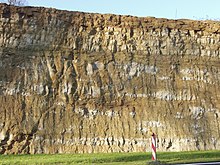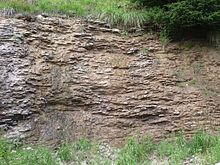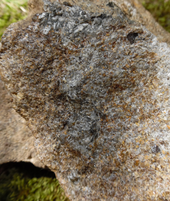Hettangium
| system | series | step | ≈ age ( mya ) |
|---|---|---|---|
| higher | higher | higher | younger |
| law | Upper Jurassic | Tithonium | 145 ⬍ 152.1 |
| Kimmeridgium | 152.1 ⬍ 157.3 |
||
| Oxfordium | 157.3 ⬍ 163.5 |
||
| Middle Jurassic | Callovium | 163.5 ⬍ 166.1 |
|
| Bathonium | 166.1 ⬍ 168.3 |
||
| Bajocium | 168.3 ⬍ 170.3 |
||
| Aalenium | 170.3 ⬍ 174.1 |
||
| Lower Jurassic | Toarcium | 174.1 ⬍ 182.7 |
|
| Pliensbachium | 182.7 ⬍ 190.8 |
||
| Sinemurium | 190.8 ⬍ 199.3 |
||
| Hettangium | 199.3 ⬍ 201.3 |
||
| deeper | deeper | deeper | older |
The Hettangium (in German often shortened to Hettang , more rarely also modified to Hettangien) is a chronostratigraphic stage of the Jura in geological history , which geochronologically corresponds to the period from 201.3 to 199.3 million years ago and thus lasted about two million years. The hettangium is the first (oldest) stage of the Jurassic (or the Lower Jurassic series) and follows the stage of the rhaetium of the Upper Triassic . The Hettangium is followed by the Sinemurium .
History and naming
The hettangium was named after the place Hettange-Grande ( Département Moselle ) in Lorraine (France). The stage and name were suggested by Eugène Renevier in 1864.
Definition and GSSP
The beginning of the hettangium is defined by the first appearance of the ammonite species Psiloceras spelae * . The GSSP (= "Global Stratotype Section and Point", corresponds roughly to a type profile) is located on the Kuhjoch in the Karwendel in Austria . The first appearance of the ammonite genera Vermiceras and Metophioceras was set as the upper limit or rather as the beginning of the Sinemurian .
Breakdown
The hettangium has so far been divided into three well-defined ammonite zones and nine subzones (from hanging to lying ):
- Zone of Schlotheimia angulata
- Subzone of Schlotheimia depressa
- Subzone of Schlotheimia complanata
- Subzone of Schlotheimia extranodosa
- Zone des Alsatites liasicus
- Alsatites liasicus subzone
- Subzone of Alsatites laqueus
- Subzone of the Waehneroceras portlocki
- Zone des Psiloceras planorbis
- Subzone of the Caloceras torus
- Subzone of Caloceras johnstoni
- Subzone of Psiloceras planorbis
However, the further subdivision of the Lower Hettangium has not been fully clarified. These layers are often summarized as "preplanorbis layers". Some authors distinguish different biostratigraphic horizons within the "preplanorbis layers", including an unnamed zone in Europe with Neophyllites antecedens and Neophyllites imitans, as well as Psiloceras erugatum . Below the erugatum horizon then follows the Psiloceras tilmanni zone with Psiloceras pacificum , Psiloceras tilmanni and Psiloceras spelae at the base.
Sea level
In general, the sea level was rising during the entire Hettangian period (Hettangic transgression). However, three regression / transgression cycles were superimposed on this long-term trend. Immediately at the beginning of the hettangium there was a drastic decrease, the regression He 1 . The second regression He 1.1 then occurred at the beginning of the Caloceras johnstoni subzone . He 2 was at the beginning of the Alsatites liasicus zone . He 3 finally separated the Schlotheimia extranodosa from the Schlotheimia complanata subzone . After this last regression, the sea level rose again further into the Sinemurium. The three cycles showed increasing intensity towards the hanging wall.
Chemical stratigraphy
Carbon isotopes
The δ 13 C values for the hettangium range between 1 and 2 ‰ (PDB), with their maximum in the middle section. They are therefore generally somewhat lower than in the rest of the Jura, i.e. H. the organic carbon production was lower or the prevailing conditions a little more anoxic and restrictive.
Oxygen isotopes
The values for δ 18 O are - 2 ‰ (PDB) with a slightly increasing tendency. With the exception of the Toarcian, they are lower than in the rest of the Jura and suggest a fairly warm climate in the Hettangian, which, however, gradually cooled.
Strontium isotopes
The ratio of 87 Sr / 86 Sr in sea water was very high with an average of 0.7077. It reached a maximum value at the end of the hettangium and then fell steadily until the beginning of the toarcium. The drop in the strontium ratio after the hettangium is correlated with increased submarine volcanism and is likely to reflect the increasing opening of the North Atlantic (breaking up of the Pangea and reducing continental sediment input).
Biostratigraphy
Dinoflagellates
The hettangium forms the lower half of the dinoflagellate zone Dpr , named after the predominant taxon in the boreal region, Dapcodinium priscum . As a zone designation for the Hettangian also is DSJ1 in use.
Calcareous nannoplankton
The calcareous nannoplankton appeared for the first time in the world's oceans shortly before the start of the hettangium with the end-Triassic transgression.
The hettangium belongs entirely to the nannoplankton zone NJ1 , which is characterized by the first appearance ( FAD ) of the taxon Schizosphaerella punctulata . This ends with the first appearance of Parhabdolithus liasicus .
Foraminifera
Based on the foraminifera , three zones can be identified for the hettangium:
- Upper zone with the taxa Vaginulina subporrecta and Ychtyolaria xyphoidea
- Middle zone with lenticulina quadricosta
- Lower zone with the taxa Lingulina striata , Lingulina collenoti and Lenticulina austroalpina .
Living world
Mass extinction
The turn of the Triassic / Jurassic is one of the five most important mass extinctions in the history of the earth. The conodonts fell victim to this event , but there was also a drastic decline in biodiversity among the ammonites and the bivalvia.
fauna

During the Hettangian, the seas were populated by predatory ichthyosaurs with the taxon Ichthyosaurus , Leptonectes and Temnodontosaurus, and by plesiosaurs with Atychodracon , Macroplata and Rhomaleosaurus . They were the predators of the ammonites , which gradually spread again in the oceans after the extinction event at the Triassic-Jura border. The appearance of the neoammonoids (ammonites in the narrower sense) in the early Hettangian is characteristic of the fauna change at the Triassic-Jura border. These undergo a relatively fast radiation , so that a larger number of genera and species already existed again in the middle Hettangian. In contrast to later epochs, the fossilization conditions were apparently not optimal, so that only a few sites with well-preserved hettangium ammonites are known worldwide.
In the continental vertebrate fauna were dinosaurs prevalent, including the bird dinosaurs ( Ornithischia ) with the "primitive" species Abrictosaurus , fabrosaurus , Heterodontosaurus , Lanasaurus , Lycorhinus , Scelidosaurus , scutellosaurus and Stormbergia and lizards dinosaurs ( Saurischia ) with theropods such Lophostropheus and the oldest Jurassic Dracoraptor dinosaur . The body fossil record of the terrestrial vertebrates of the Hettangium is generally sparse. It is different with corresponding trace fossils . The localities in the Mecsek Mountains in Hungary, from which the genus Komlosaurus was described, offer a European example . In North America, extensive trace material is found on the east coast in the sediments of the Newark supergroup .
The airspace was dominated by "primitive" (long-tailed) pterosaurs such as Dimorphodon .
Typical representatives of the archosaur crocodile line are Sphenosuchus and Protosuchus , an early genus of the "crocodiles in the broader sense" ( Crocodyliformes ).
As a representative of early mammals is Haramiya to name.
Occurrence
The hettangium is (partially) represented in the following countries in the form of the following rock units (selection):
- China :? Lufeng formation
-
Germany :
- Northwest Germany : "Psilonoten layers" and overlying "Angulate layers"
- Southern Germany : Psilonotenton Formation and overlying Angulate Clay Formation or Angulate Sandstone Formation (the latter in Franconia now referred to as the Bamberg Formation , with the Bayreuth Formation as the continental lateral equivalent)
- England : Blue Lias formation
-
France :
- Aquitaine basin : basal transgression sequence of the Hettangium and Sinemurium
- Paris basin : contains the original (eponymous) stratotype, the Grès d'Hettange , which wedges against the Calcaire à gryphées
- India : Kota formation
- Lesotho and South Africa : Elliot formation of the Karoo supergroup
- Austria : Schattwalder layers , Kendlbach formation (see Kuhjoch ) and Schnöll formation of the Northern Limestone Alps
- Switzerland : insect marl and above it the Cardinienkalk in the Swiss Jura
- Zimbabwe : Forest Sandstone , Vulcanodon Beds
- United States : Meriden Group and Portland Group of the Newark Supergroup
Individual evidence
- ↑ A. v. Hillebrandt, L. Krystyn, WM Kürschner, NR Bonis, M. Ruhl, S. Richoz, MAN Schobben, M. Urlichs, PR Bown, K. Kment, CA McRoberts, M. Simms, A. Tomãsových: The Global Stratotype Sections and Point (GSSP) for the base of the Jurassic System at Kuhjoch (Karwendel Mountains, Northern Calcareous Alps, Tyrol, Austria). Episodes. Vol. 36, No. 3, 2013, pp. 162–198 ( PDF 7.9 MB)
- ^ Jean Guex: Relations entre le genre Psiloceras et les Phylloceratida au voisinage de la limite Trias-Jurassique. Bulletin de la Société Vaudoise des Sciences Naturelles. Vol. 76, No. 361, 1982, pp. 47-51, doi: 10.5169 / seals-278144
- ↑ Bloos, G .: Aspects of the turn Trias / Jura . Ed .: N. Hausche & V. Wilde. Trias - a completely different world. Dr. Friedrich Pfeil, Munich 1999, p. 43-68 .
- ↑ Martin D. Ezcurra, Gilles Cuny: The coelophysoid Lophostropheus airelensis , gen. Nov .: a review of the systematics of “Liliensternus” airelensis from the Triassic-Jurassic outcrops of Normandy (France). Journal of Vertebrate Paleontology. Vol. 27, No. 1, 2007, pp. 73–86, [[doi: 10.1671 / 0272-4634 (2007) 27 [73: TCLAGN] 2.0.CO; 2]] (alternative full text access: ResearchGate )
- ↑ David M. Martill, Steven U. Vidovic, Cindy Howells, John R. Nudds: The Oldest Jurassic Dinosaur: A Basal Neotheropod from the Hettangian of Great Britain. PLoS One. Vol. 11, No. 4, 2016, Item No. e0154352, doi: 10.1371 / journal.pone.0145713
- ↑ Attila Ősi, József Pálfy, Lászlá Makádi, Zoltán Szentesi, Péter Gulyás, Márton Rabi, Gábor Botfalvai, Kinga Hips: Hettangian (Early Jurassic) Dinosaur Tracksites from the Mecsek Mountains, Hungary. Ichnos. Vol. 18, 2011, pp. 79-94, doi: 10.1080 / 10420940.2011.573603
- ^ Robert E. Weems, Lawrence H. Tanner, Spencer G. Lucas: Synthesis and revision of the lithostratigraphic groups and formations in the Upper Permian? –Lower Jurassic Newark Supergroup of eastern North America. Stratigraphy. Vol. 13, No. 2, 2016, pp. 111-153
literature
- Gert Bloos and Kevin N. Page: Global Stratotype Section and Point for base of the Sinemurian Stage (Lower Jurassic) . In: Episodes . tape 25 (1) . Beijing 2001, p. 22-28 . PDF
- Felix Gradstein, Jim Ogg, Jim & Alan Smith: A Geologic timescale . Cambridge University Press, 2005, ISBN 978-0-521-78673-7 .
- Hans Murawski & Wilhelm Meyer: Geological dictionary. 10., rework. u. exp. Ed., 278 . Enke Verlag, Stuttgart 1998, ISBN 3-432-84100-0 .
- Eugène Renevier: Notices géologiques et paleontologiques sur les Alpes Vaudoises, et les régions environnantes. I. Infralias et Zone à Avicula contorta (Ét. Rhaetien) des Alpes Vaudoises. In: Bulletin de la Société Vaudoise des Sciences Naturelles . tape 8 . Lausanne 1864, p. 39-97 .
Web links
- German Stratigraphic Commission (Ed.): Stratigraphische Tisch von Deutschland 2002 . Potsdam 2002 ISBN 3-00-010197-7 (PDF; 6.57 MB)
- Commission for the paleontological and stratigraphic research of Austria of the Austrian Academy of Sciences (Ed.): The Stratigraphic Table of Austria (sedimentary layer sequences). Vienna 2004 (PDF; 376 kB)
- International Chronostratigraphic Chart 2017/02 (PDF)
- Hettangium ammonites from the Alps, Peter Reiter




